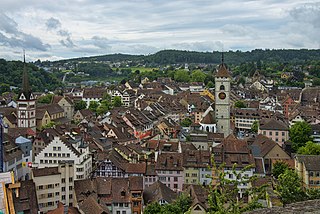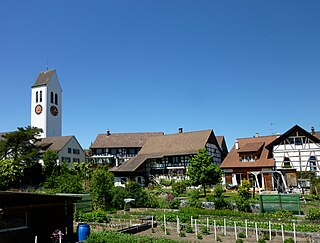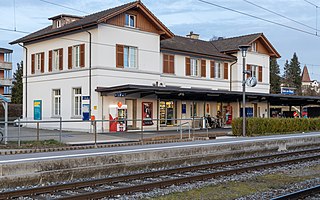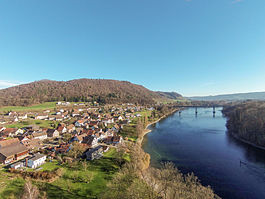
Schaffhausen, historically known in English as Shaffhouse, is a town with historic roots, a municipality in northern Switzerland, and the capital of the canton of the same name; it has an estimated population of 36,000 as of December 2016. It is located right next to the shore of the High Rhine; it is one of four Swiss towns located on the northern side of the Rhine, along with Neuhausen am Rheinfall, the historic Neunkirch, and medieval Stein am Rhein.

The canton of Schaffhausen, also canton of Schaffhouse, is the northernmost canton of Switzerland. The principal city and capital of the canton is Schaffhausen. The canton's territory is divided into three non-contiguous segments, where German territory reaches the Rhine. The large central part, which includes the capital, in turn separates the German exclave of Büsingen am Hochrhein from the rest of Germany.
Stein am Rhein is a historic town and a municipality in the canton of Schaffhausen in Switzerland.

Thayngen is a village and a municipality in the canton of Schaffhausen in Switzerland. The neighboring village Barzheim merged with Thayngen on 1 January 2004. On 1 January 2009 Altdorf, Bibern, Hofen and Opfertshofen merged into Thayngen.

Neuhausen am Rheinfall is a town and a municipality in the canton of Schaffhausen in Switzerland.

Büttenhardt is a municipality in the canton of Schaffhausen in Switzerland.

Dörflingen is a village and a municipality in the canton of Schaffhausen in Switzerland. It borders a short strip of the north shore of the Rhine.

Hallau is a municipality in the canton of Schaffhausen in Switzerland.

Lohn is a municipality in the canton of Schaffhausen in Switzerland.

Löhningen is a municipality in the canton of Schaffhausen in Switzerland.

Oberhallau is a municipality in the canton of Schaffhausen in Switzerland.

Ramsen is a municipality in the canton of Schaffhausen in northern Switzerland.

Rüdlingen is a municipality in the canton of Schaffhausen in Switzerland.

Siblingen is a municipality in the canton of Schaffhausen in Switzerland.

Eschenz is a municipality in Frauenfeld District in the canton of Thurgau in Switzerland.

Diessenhofen is a village and a municipality in Frauenfeld District in the canton of Thurgau in Switzerland. The village is situated on the south shore of the High Rhine just opposite the German town of Gailingen am Hochrhein.

Oberstammheim is a former municipality in the district of Andelfingen in the canton of Zürich in Switzerland.

Ossingen is a municipality in the district of Andelfingen in the canton of Zürich in Switzerland.

Stein am Rhein railway station is a railway station in the Swiss canton of Schaffhausen and the municipality Stein am Rhein. The station is situated on the opposite (southern) bank of the Rhine to the historic centre of the town, a walk of some 500 m (1,600 ft). It is located on the Lake line, which links Schaffhausen with Rorschach.

The border between the modern states of Germany and Switzerland extends to 362 kilometres (225 mi), mostly following Lake Constance and the High Rhine, with territories to the north mostly belonging to Germany and territories to the south mainly to Switzerland. Exceptions are the Swiss canton of Schaffhausen, the Rafzerfeld of the canton of Zürich, Bettingen and Riehen municipalities and part of the city of Basel in the canton of Basel-City and the old town of the German city of Konstanz, which is located south of the Seerhein. The canton of Schaffhausen is located almost entirely on the northern side of the High Rhine, with the exception of the southern part of the municipality of Stein am Rhein. The German municipality of Büsingen am Hochrhein is an enclave surrounded by Swiss territory.

























